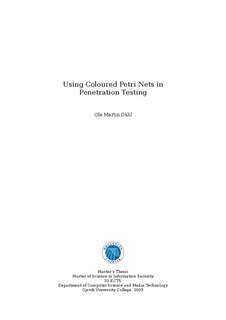Using Coloured Petri Nets in Penetration Testing
Master thesis
Permanent lenke
http://hdl.handle.net/11250/143799Utgivelsesdato
2005Metadata
Vis full innførselSamlinger
Sammendrag
NORSK:
Nettverkspenetrasjonstesting er en velkjent metode brukt innen sikkerhetstesting. Penetrasjonstesting
kan være en omfattende oppgave som krever mye kunnskap og ekspertise,
med mange forskjellige teknikker, og et vidt antall verktøy i bruk under prosessen.
En metodisk tilnærming til penetrasjonstesting er derfor anbefalt. "The flaw hypothesis
methodology", som denne oppgaven baserer seg på, representerer en av de mest
brukte modellene for penetrasjonstesting. Det finnes likheter til denne modellen i de
fleste metoder og standarder innen penetrasjonstesting brukt i dag.
Petri net er et graf basert modeleringsspråk, opprinnelig tiltenkt for modellering av
systemer med samtidighetsproblematikk. Grafene gir en intuitiv måte å modellere, simulere
og eksekvere modeller. "Coloured Petri net" er en type høynivå Petri net som gir flere muligheter
til detaljmodellering og sammensetting av Petri net.
The flaw hypothesis methodology er brukt sammen med forskjellige typer coloured
Petri net for modellering av systemangrep i penetrasjonstestingsprosessen. Metoden er
beskrevet og analysert gjennom tre testscenarioer, som belyser egenskapene ved Petri
net modellering av angrep i penetrasjonstesting. Fordeler ved Petri net angrepsmodelleringen
har blitt utforsket og beskrevet. Mange av egenskapene til coloured Petri nets
har visst seg å fungere bra til angrepsmodellering under penetrasjonstesting, for eksempel
egenskapene grafene har til å modelere tilstander, transisjoner, samtidighet, og tidsbergning. ENGELSK:
Network penetration testing is a well-known approach used for security testing. Penetrating
testing can be a laborious task which relies much on human knowledge and
expertise, with various techniques employed, and an extensive amount of tools used in
the process. A methodical approach to penetration testing is therefore recommended.
The flaw hypothesis methodology, used in this thesis, represent one of the most used
models for penetration testing and have great similarities in other penetration testing
methodologies and standards used today.
Petri nets represent a graph based mathematically sound modelling technique for concurrent
systems, and provide a graphically intuitive approach for modelling, simulation
and execution. A coloured Petri net is a high level Petri net that provides a significant
increase in the expressiveness and compactness of Petri net models.
The flaw hypothesis methodology used together with coloured Petri net attack models
is presented in the thesis. The use of coloured Petri nets is described and analysed
through case studies elucidating several properties of Petri net variants and their suitability
to modelling attacks in penetration testing. Advantages of modelling attacks with
coloured Petri nets have been explored and are described. Coloured Petri nets have been
found to have many usefull mechanisms for modelling, analysing, and automatically
executing penetration attempts, e.g. through their ability to model states, transitions,
concurrency, and timing.
The overall topic of the thesis is the technical aspects of penetration testing, what it
is, and a methodical approach to it.
